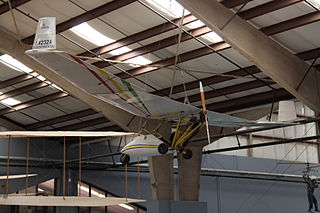
The Remos G3 Mirage and Remos GX are German high wing, two seat, single engine light aircraft, built by Remos AG of Pasewalk. The aircraft is supplied as a kit for amateur construction or complete and ready-to-fly.
The TeST TST-13 Junior is a single-seat touring motor glider with a nose-mounted engine, built by TeST in Czech Republic. It is an all composite design which succeeded the TeST TST-9 Junior motor glider in production, incorporating some features of the TeST TST-10 Atlas sailplane, including its wing.

The Alpaero Choucas is a French two seat, single engine tailless kit-built ultralight motor glider. At least 12 are flying, with more under construction.
The Alpaero Exel is a French single seat, single engine pusher pod-and-boom kit-built ultralight motor glider. About 10 had been produced by 2005.

The LO 120 S is a German parasol-wing, pusher configuration, open-cockpit, two-seats in tandem motor glider that was designed and produced by LO-Fluggerätebau. When it was available it was supplied as a kit for amateur construction and meets European microlight rules.

The Volmer VJ-24W SunFun is an American high-wing, strut-braced, single-seat, pod-and-boom motor glider and ultralight aircraft that was designed by Volmer Jensen and provided as plans for amateur construction by his company Volmer Aircraft of Glendale, California.
The Barel Graal is a French mid-wing, T-tailed single-seat motor glider that was designed by Max Barel and produced by Graal Aéro as a complete ready-to-fly aircraft or as a kit for amateur construction.
The Aérostructure Lutin 80, earlier known as the PLM 80, is a small, single seat motor glider with a low power pusher configuration engine, designed and built in France in the 1980s. Only two were completed.
The Corcoran 65-1 was a motor glider of very unusual configuration, a twin engine biplane. It was designed and built in the United States in the 1960s; only two were completed.

The Mitchell Wing B-10 is an American high-wing, open cockpit, single-seat, tailless, ultralight aircraft and motor glider designed by Don Mitchell and based on his Mitchell Wing hang-glider. It has been produced by a variety of companies in the form of kits and plans for amateur construction. It first flew in 1980.
The Farner HF Colibri 1 SL was an unusual canard motor glider with a unique control system, designed and built in Switzerland in the late 1970s. Only one was constructed; much modified during the 1980s, it was still flying in 1990.
The Silent Family Silent Glider M is a German ultralight trike motor glider, designed by Helmut Grossklaus and produced by Silent Family of Westerrade. The aircraft is supplied as a complete ready-to-fly-aircraft.
The Bonomi BS.19 Alca was a single seat, tractor configuration motor glider, designed and built in Italy shortly before World War II. It had an unusual retractable undercarriage used only for take-offs. Only one was built.
The Bonomi BS.22 Alzavola was a training motor glider, intended to acquaint capable glider pilots with the characteristics of powered aircraft. The sole example was designed and built in Italy in the mid-1930s.
The Teichfuss Cicogna was an Italian tailless single-seat motor glider designed by Luigi Teichfuss and flown in 1936.
The Kortenbach & Rauh Kora 1 was an unusual twin boom, pusher configuration motor glider, designed and built in Germany in the 1970s and intended as a training aircraft.
The IIL IS-9 was a low powered, experimental pod and boom style motor glider, designed and built in Romania in the late 1950s.
The Gribovsky G-15 was a single engine, side-by-side two seat touring aircraft built in USSR in the 1930s. Only one was completed.
The Avia 50-MP was a French motor glider based on that of the Avia XV-A training glider. First flown in 1934, it was intended to introduce pilots to motor-gliders.
The Avia 60-MP was a French motor glider with a wing based on that of the Avia 32-E, an advanced training glider. It was intended as both an advanced trainer and as an atmospheric research aircraft.





